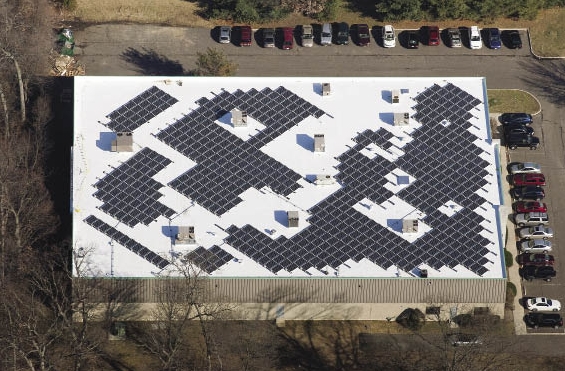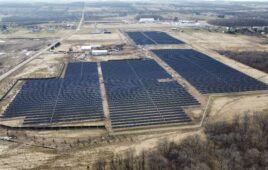Rooftops are great for solar, but only when important considerations are addressed
By Tony Ruffine
 As North America’s largest roofing manufacturer, we know that rooftops are a great location for solar. Roofs are out of the way, tend to have the least shade on a property, are close to utility hookups and usually do not need additional infrastructure. As a result, approximately 80% of solar installations take place on roofs. We have worked closely with the solar industry for several years and are big advocates of rooftop solar.
As North America’s largest roofing manufacturer, we know that rooftops are a great location for solar. Roofs are out of the way, tend to have the least shade on a property, are close to utility hookups and usually do not need additional infrastructure. As a result, approximately 80% of solar installations take place on roofs. We have worked closely with the solar industry for several years and are big advocates of rooftop solar.
Working with the best players in the industry, we have seen some great solar projects on top of our roof systems. Unfortunately, many solar buyers and installers do not understand the interplay between the roofing system and solar. Most of us have heard a job sold with some variation of the line: “There are no penetrations so it does not affect your roof warranty.” When we at GAF hear that, we can be almost certain there will be a problem.
Choosing the Right Installer
A lot of solar installers take the roofing piece for granted or do not have the experience with roof top installations to understand the challenges of each roof. That is why choosing an EPC that is familiar with the roof, such as Advanced Green Technologies, is crucial. The property owner should insist on a solar installer with genuine roofing experience. Here are some tips for choosing a qualified solar installer:
• Ask the installer about other rooftop installations they have completed.
• Make sure the installer is respected by roofing-system providers.
• Ensure the company has installed solar on multiple roofing systems using a variety of technologies.
• The installer should be able to discuss rooftop conditions, know how the roof drains, have a strong familiarity with wire management plans, provide roof replacement and repairs, take down and re-install a system during roof replacement and repair and can provide follow up maintenance services.
Proper Planning
If a property owner is considering solar, the roof system should be designed with the future installation in mind. Design considerations like slope or placement of drains and scuppers should be done to allow maximum solar coverage. The roof system should also be chosen to support solar. High-density cover boards, for example, should be used when solar will be installed.
Membrane systems should not be loosely laid or mechanically attached, but should be fully adhered. Higher performance membranes provide cheap insurance up front. Walkway pads should be used around the solar (and slip sheets are usually recommended underneath). Most importantly, the roof installation needs to be staged to facilitate the solar installation, considering both schedules.
Common Installation Problems
A successful solar installation is not just one that generates the required amount of electricity. It also has to leave the building in serviceable condition. There is no such thing as a good solar installation on a leaky or damaged roof. Even today, in states where there is a long history of solar installations, we see problems when the solar installer did not understand or take into account conditions on the roof. A few of these problems seem to come up repeatedly:
1. Not matching the roof life to the solar installation’s life. This one should be obvious. A solar installation may generate power for 20 years or more and have financing or PPA lengths just as long. Putting a solar installation that may last 20 years on a roof that, like many new construction roofs, is only designed to last 10 years is asking for problems. A variety of roof systems, however, can last 20 years. Also, membranes are designed for conditions on solar rooftops and so can be warranted for 35 years. Membranes are the protective, waterproofing top layer of a roofing system.
2. Not matching the roof design to solar. Because solar has specific performance criteria, there are points to consider when choosing a roof system to ensure the best solar performance. Solar panels, for example, tend to work best in cooler environments, so a cool membrane can provide better electrical output. Roof systems are also not usually designed for the weight of solar projects or for the foot traffic that installation and maintenance can bring. Understanding the roofing membrane is even more important when considering the potential for directly attached panels in the future. Many membranes will have compatibility issues with these designs. Ensuring the roof is solar-ready up front will avoid a lot of unnecessary work in the future.
3. Not understanding the flow of water. A good roof system should drain water away from the rooftop and shed it away from the building. But racking and wire harnesses can inhibit water flow, preventing water from draining in a timely manner. Even worse, water may be forced in the wrong direction, causing a leak. We have also seen drains clogged when cheap ballast disintegrated and ran out of the ballast tray. Repairs can be more difficult when solar is installed, so it’s important to take account of these concerns up front.
4. Not considering thermal movement or wind/seismic events. We recently visited a rooftop solar installation with 250-ft long racks and no slip-sheets. The rate of thermal expansion on these racking systems was about 0.25%, which means the racks could be moving a little over a foot with each thermal cycle. We have also seen systems damaged from wind because the ballast was not properly installed and the system moved. Taking precautions during installation will avoid many problems.
5. Not understanding rooftop conditions during installations. A good roof system is durable, but it’s not designed to be used as a construction site. Dragging panels or racking across the membrane will damage even the heartiest roof. Dropping tools can penetrate roof membranes. Debris will clog drains or cause other problems. We have seen staging areas on new roofs look like they were 15 years old by the time the solar installation is complete. While this problem was more common a few years ago, seeing roofs torn up from solar installation is still too common.
6. Not having a maintenance plan. Basic maintenance and inspections are necessary on commercial roofs without solar, and the need for maintenance is heightened when solar is installed. We have seen some solar installations with plants growing around panels, and others that end up in the water when a drain clogs. Crews that are used to finding problems with roofing and solar help avoid problems up front and catch other small problems before they become big issues.
Many other rooftop issues can arise with solar. As new installation methods are developed, their effect on the roof system must be seriously considered.
Roofing and solar make a lot of sense together. In the future, we expect the roof and solar integration to become much easier. Forward thinking property owners and solar buyers will wisely choose the right solar installer, select the right roofing materials and design a robust roof system to guarantee the best performance from any solar installation. SPW
Tony Ruffine is vice president of GAF, a North Americian manufacturer of commercial and residential roofing. The company was founded in 1886 and is currently headquartered in Wayne, N.J.






>Not matching the roof life to the solar installation’s life. This one should be obvious.
SHOULD be obvious… but you wouldn’t believe how many times I’ve seen people make this mistake! Thankfully it’s not the complete end of the world, but it definitely creates a bunch of unnecessary work when the roof needs replaced.
Hopefully someone sees this as I know it’s an old thread. So I had solar panels installed on the front roof in April 2015. Last night my roof started leaking in the back, very high up. My concern: While installing, the safety rope for the installers was draped over the roof vent that runs the length of the roof and down the back of the house to some kind of anchor. The taught rope slid back and forth as they were installing. I noticed the roof vent dented and misshapen in a few areas. Could a wind driven rain be getting under the peak roof vent in a section that was damaged, causing rain to get between the shingles and the plywood? The leak in the attic is about 2 feet from the peak, dripping in from a shingle nail hole. No roof leaks for 12 years prior. Plausible?
As a person who cleans gutters for work, ive seen solar panels which were poorly installed. I remember the gutters of a 3 story apartment building. Because the solar panels were so close to the gutters it was dangerous to even try to clean the gutters. Whoever installed the panels expected repairmen to handle only 1 foot of shingle space between gutters and solar panels at 3 stories high. Also add that the roof was at a steep incline. Luckily we found a 35ft ladder to hang off the building and nobody was hurt. Also what caused the gutters to clogg was birds nesting beneath the solar panels leaving their poop, nest and carcasses behind. Im all for the environment but leave some some roof space for your gutters. if your house is only one story, by all means maximize efficiency because Ill be able to hang a light 10 foot step ladder on the edge of your roof.
on a side note, I also wash solar panels…. but with dishsoap and hose water. Dont buy into the ionized water bullshit. Whoever tells you panels must strictly be washed by special water is pretty much selling bottled water coming from the sink.
Step 1 should be really step 2. Step 1 should be to consult a registered roof consultant to discuss the project and make sure the roof is sound. Then acquire their services to monitor the solar installation. All it take is a young inexperienced solar installer to cause serious damage to the roof structure. Most of the large fortune 200 companies follow this process. I recommend an outfit of NJ called Roof Maintenance Systems and they have 2 registered roof consultants on staff and their work is meticulous.
Great information! The first section is key – choosing the right solar installer. A dealer with a long track record is unlikely to have a lot of angry customers coming after them for roof problems. The thermal expansion thing drives me crazy. Unirac, a major manufacturer of aluminum rail systems, requires a thermal expansion break every 35 feet. Not only do many installers perform this break incorrectly, but they also fail to provide proper grounding between rail sections.
One thing I would recommend doing is ask to speak to an installer or job foreman about the technical aspects. The salesperson may be very qualified at determining the best products, orientation, and system output, but the nuts and bolts that connect your system to the roof is the realm of the installer.
Jason Szumlanski
Vice President
Fafco Solar
http://FafcoSolar.com
Is it possible for the roofing contractor in ft lauderdale to combine solar cells with roofing materials. Will it effect the life of solar panel and the roofs. Or is it advisable to have a solar panel embedded in roofing materials.